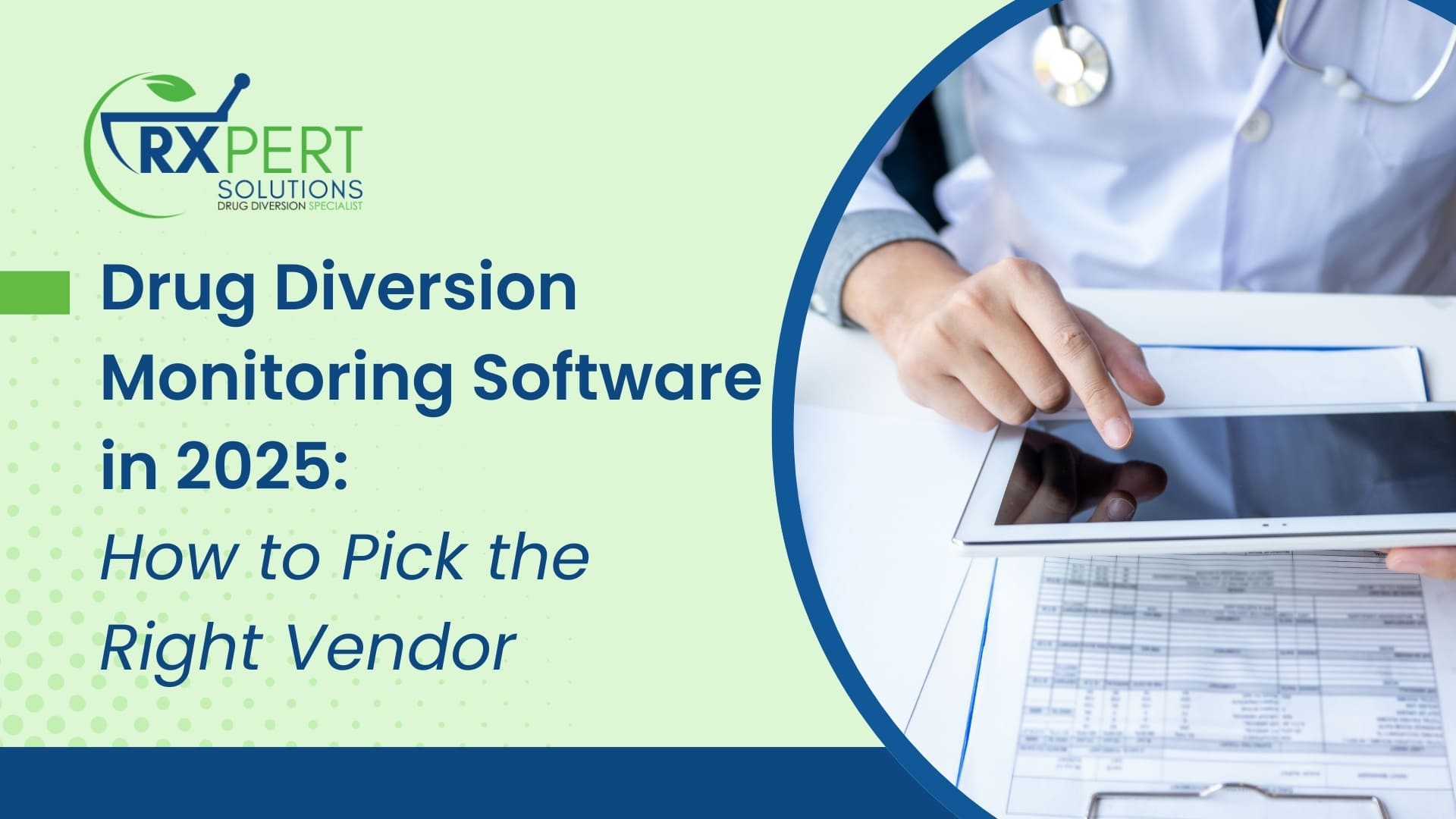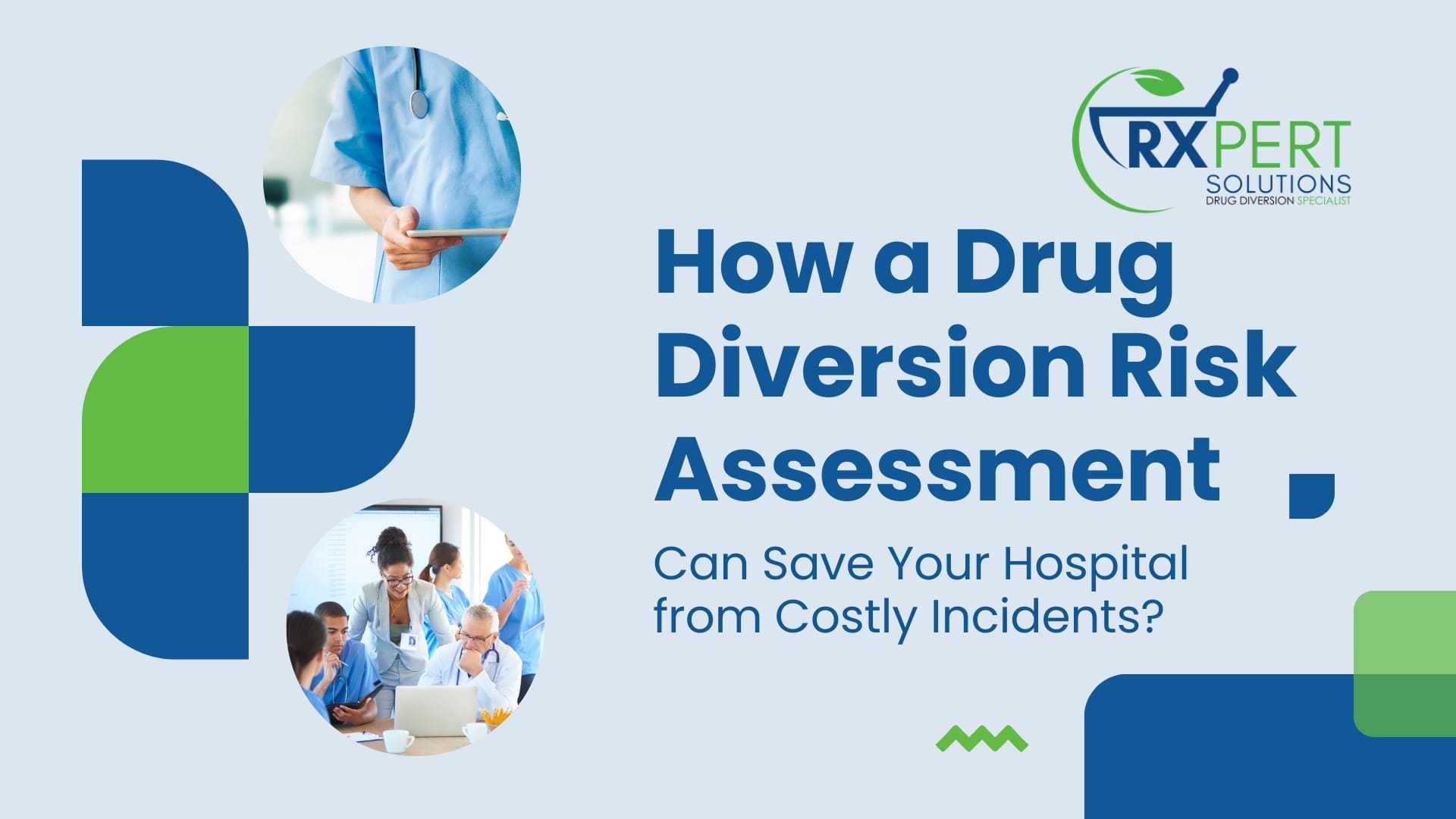The Role of Drug Diversion Monitoring Software in 2025 Mitigation Strategies
The drug diversion software market has changed more in the past three years than in the previous decade.
Once crowded with niche vendors and point solutions, it is now dominated by a few consolidated platforms and a handful of independent innovators.
For hospitals, pharmacies, and health systems, the stakes couldn’t be higher.
- 10–15% of healthcare workers misuse substances during their career.
- False positives from monitoring tools waste hundreds of compliance hours.
- Workflow blind spots — like OR cases not charted electronically or meds bypassing ADCs — leave entire care areas unmonitored.
⚠️ Having software doesn’t mean having a defensible diversion program.
In 2025, the question isn’t “Which software has the best features?” — it’s Which vendor’s philosophy fits your compliance strategy, resources, and risk profile?
In this article, Rxpert Solutions provides independent, vendor-agnostic analysis of four key players:
- Wolters Kluwer (Sentri7 + Invistics AI)
- Bluesight (ControlCheck + Medacist + Protenus)
- HelioMetrics
- Anigent
👉 Explore Vendor Strengths & Weaknesses Side by Side
Why Diversion Mitigation Matters More Than Prevention
Traditionally, compliance teams spoke about “drug diversion prevention.”
But in reality, total prevention is impossible — determined insiders will always find gaps.
That’s why the industry is shifting toward diversion mitigation:
- Detect diversion faster.
- Reduce false positives.
- Build workflows that withstand regulatory scrutiny.
The best drug diversion monitoring software doesn’t just spot anomalies — it integrates into daily workflows, minimizes wasted time, and produces reports that stand up in audits and litigation.
The 2025 Vendor Landscape
The drug diversion surveillance software market went through massive consolidation:
- Bluesight acquired Medacist (2023) and Protenus (2025) → forming the leading Medication Intelligence platform.
- Wolters Kluwer acquired Invistics (2023) → embedding NIH-funded AI into its Sentri7 platform.
- Smaller independents like HelioMetrics and Anigent remain, but face pressure from larger rivals.
Despite the consolidation, independents still matter. Why? Because not every hospital wants to be locked into an enterprise platform.
Common Workflow Blind Spots in Diversion Monitoring
Even the best diversion monitoring software can miss critical risks if workflows aren’t fully mapped.
Some blind spots we see frequently at Rxpert Solutions:
- Operating Rooms (ORs): Medications pulled but not charted electronically.
- Waste Handling: Discrepancies between documented and actual wasted doses.
- ADC Bypass: Controlled substances obtained outside automated dispensing cabinets.
- Manual Overrides: Overrides during system downtime or emergencies.
- HR Integration: Staff with prior incidents not flagged across facilities.
These blind spots explain why “just turning on the software” is not enough.
Hospitals must validate feeds, tune logic, and train staff — otherwise diversion slips through.
👉 Find your blind spots before regulators do — book a Free 30-min Risk Check.
The False Positives Problem
False positives are one of the biggest frustrations in drug diversion detection software.
- Alerts are often triggered by innocent workflow quirks.
- Compliance teams spend hundreds of hours chasing dead ends.
- Real diversion cases risk being buried in noise.
This is where vendors differ sharply:
- Some use advanced AI/ML to reduce noise (Bluesight, Wolters Kluwer Sentri7).
- Independents like HelioMetrics emphasize custom logic tuning.
- Anigent incorporates waste assay analysis to add physical verification.
Hospitals choosing software should weigh not just accuracy but also investigation efficiency.
Vendor Profiles (2025)
1. Wolters Kluwer (Sentri7 + Invistics AI)
- Market Position: Trusted by 700+ hospitals; global healthcare technology leader.
- Technology: NIH-validated Invistics Flowlytics AI integrated into the Sentri7 platform.
- Key Features:
- Proprietary HEAT™ score across 60+ diversion determinants.
- Pulls data from EHRs, ADCs, wholesalers, HR systems.
- Fully integrated with infection prevention and antimicrobial stewardship.
- Proprietary HEAT™ score across 60+ diversion determinants.
- Advantages:
- Enterprise-wide standardization.
- Strong brand recognition and trust.
- Enterprise-wide standardization.
- Risks:
- Feedback notes heavy manual workload for investigations (KLAS 2025 Report).
- Feedback notes heavy manual workload for investigations (KLAS 2025 Report).
Best fit: Large health systems seeking a trusted enterprise surveillance ecosystem.
2. Bluesight (ControlCheck + Medacist + Protenus)
- Market Position: Market leader (~40% share, 2,400+ hospitals). Backed by Thoma Bravo.
- Technology: “Medication Intelligence” suite combining acquisitions:
- ControlCheck (Best-in-KLAS diversion monitoring).
- Medacist → 20+ years of diversion data + patented analytics.
- Protenus (now PrivacyPro) → AI-driven analytics + patient privacy monitoring.
- ControlCheck (Best-in-KLAS diversion monitoring).
- Key Features:
- All-in-one suite: diversion, privacy, inventory, purchasing optimization, 340B compliance.
- All-in-one suite: diversion, privacy, inventory, purchasing optimization, 340B compliance.
- Advantages:
- Simplifies procurement (one vendor, one platform).
- Deep specialization in pharmacy operations.
- Simplifies procurement (one vendor, one platform).
- Risks:
- High alert volumes can cause alert fatigue.
- High alert volumes can cause alert fatigue.
Best fit: Hospitals seeking a single-vendor, pharmacy-focused compliance platform.
👉 Compare Drug Diversion Software Vendors (2025)
3. HelioMetrics
- Market Position: Independent, vendor-agnostic innovator.
- Technology: Customizable dashboards, flexible data integration.
- Key Features:
- Works across EHRs, ADCs, inventory systems without lock-in.
- Fully customizable to facility workflows.
- Works across EHRs, ADCs, inventory systems without lock-in.
- Advantages:
- Freedom from vendor ecosystem restrictions.
- High degree of customization.
- Freedom from vendor ecosystem restrictions.
- Risks:
- Slower adoption rates.
- Struggles to keep up with larger vendors’ R&D.
- Slower adoption rates.
Best fit: Facilities needing flexibility and independence from enterprise ecosystems.
👉 Explore Vendor Strengths & Weaknesses Side by Side
4. Anigent
- Market Position: Small independent vendor, clinician-led.
- Technology: MAAP Analytics® platform built by a diversion specialist pharmacist.
- Key Features:
- Includes waste assay analysis — compares chemical waste data with records.
- AI-driven detection tuned for pharmacy workflows.
- Includes waste assay analysis — compares chemical waste data with records.
- Advantages:
- Built from frontline pharmacist perspective.
- Adds physical verification layer (waste analysis).
- Built from frontline pharmacist perspective.
- Risks:
- Limited adoption.
- Smaller market presence.
- Limited adoption.
Best fit: Hospitals seeking pharmacist-designed, specialized diversion monitoring.
Comparative Matrix
| Vendor | Strengths | Risks | Best Fit |
| Wolters Kluwer | Enterprise integration, NIH-backed AI, trusted brand | Manual investigation burden | Large systems |
| Bluesight | All-in-one compliance suite, Best-in-KLAS, deep dataset | Alert fatigue | Hospitals seeking unified pharmacy platform |
| HelioMetrics | Vendor-agnostic, fully customizable | Slower adoption, limited scale | Facilities valuing flexibility |
| Anigent | Pharmacist-designed, includes waste assay | Niche adoption | Hospitals wanting specialized insights |
Strategic Decision Framework
Hospitals should align software choice with their compliance philosophy:
- Enterprise Efficiency (Wolters Kluwer): Standardize on one trusted platform.
- Pharmacy Specialization (Bluesight): Go deep with an all-in-one compliance suite.
- Flexibility (HelioMetrics): Stay independent, customize workflows.
- Clinician Insight (Anigent): Leverage pharmacist-driven innovation.
👉 Get tailored recommendations in a Free Risk Assessment.
FAQs
Q1: What is drug diversion software?
It’s software that uses AI, machine learning, and analytics to detect suspicious controlled substance usage patterns.
Q2: Which vendors lead in 2025?
Bluesight (~40% share) and Wolters Kluwer (700+ hospitals) dominate. HelioMetrics and Anigent remain strong independents.
Q3: What’s the difference between diversion prevention and mitigation?
Prevention implies stopping all diversion. Mitigation acknowledges diversion risks and focuses on earlier detection + faster response.
Q4: Why do false positives matter so much?
They waste staff time, bury true cases, and erode confidence in the system. Reducing false positives is critical for compliance efficiency.
Q5: What’s the role of independents like HelioMetrics and Anigent?
They provide flexibility, independence, and clinician-driven insights that large platforms often lack.
Key Takeaways
- The drug diversion surveillance software market is consolidating.
- Bluesight leads with a unified compliance suite.
- Wolters Kluwer is the enterprise challenger with NIH-backed AI.
- HelioMetrics offers customization and independence.
- Anigent provides clinician-driven, pharmacist-designed analytics.
- Hospitals must align software choice with their strategic compliance philosophy.
Ready to evaluate which drug diversion monitoring software fits your facility?
👉 See the 2025 Drug Diversion Software Comparison
Or book a Free 30-Minute Risk Assessment with Rxpert Solutions to uncover blind spots and reduce false positives before regulators do.





